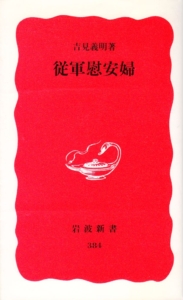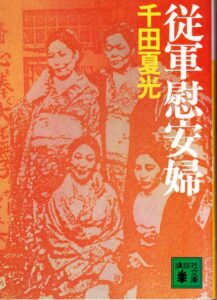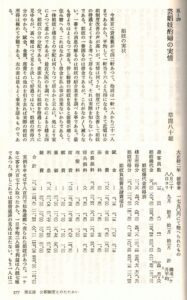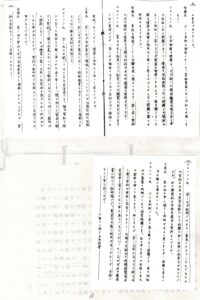Becoming a “comfort woman” was not a voluntary choice for the victims of this system. In most cases they fell into one of the following: forcibly abducted by the Japanese army; assigned by a village leader to the occupying Japanese army when the army ordered that leader to do so; duped by a trafficking agent who told some lie like there was work at a factory; or sold by one’s own impoverished parents. But no matter how they were brought to the comfort stations, the women endured confinement there against their will, unable to go outside without the military’s permission. They were forced into sexual slavery.
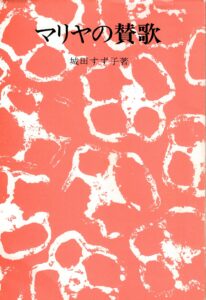
Suzuko Shirota, Maria no sanka [Maria’s Hymn]
Let us look at some cases where a woman sold by her impoverished parents to a trafficking agent of the sex or entertainment sector finds herself in growing debt bondage and subsequently transferred by the brothel manager to an agent commissioned by the Japanese military for recruiting “comfort women”. There are many victims who started out working as prostitutes and knew they were becoming “comfort women” when they entered the system. But we cannot say that these women did so of their own free will. In the early 20th century, women who worked in the prostitution or entertainment industries (for example as shogi, geiko, or shafuku) were all subject to debt bondage with no option to quit of their own will. Women who were already in a slave-like situation ended up choosing to be “comfort women” as the only option for them to pay back their debt.
A few stories:
1. Kaoruko Yamauchi (Kikumaru) was born in Yubari, Hokkaido in 1925. After her father’s failure in business drove the family into poverty, she was sold at the age of 10 to a brothel in Tokyo for 300 yen, an amount she would have to pay back from her work. As her prostitution debt multiplied, in 1942 she heard that the military would write it off if she worked for them. Hoping both that she could clear her now 4,000 yen debt, and that she would be enshrined at Yasukuni Shrine upon her death, she applied to be a “comfort women” and came to serve high-ranking military officers in Truk Island. (Sources: “Weekly Ashai Geino” Aug. 21, 1971; Bessatsu rekishi dokuhon senki shirizu dai 25-kan josei-tachi no Taiheiyosenso [Separate Volume History Reader, War Memoir, Vol. 25, Women in the Asia-Pacific War] Shin-Jinbutsuoraisha Co. Ltd., Aug. 2, 1973; Kazuko Hirota, Shogen kiroku jugun ianfu kangofu: senjo ni ikita onna no dokoku [Recorded Testimony: Military Comfort Women and Nurses, Cry of Women in the Battlefield] Shin-Jinbutsuoraisha Co. Ltd., 1975)
2. Fumi Suzuki was born in a village on Shima Peninsula, Mie Prefecture in 1924. She was sold to a brothel at the age of 7. When she was 18, in order to write off her 2,000 yen debt, she went to a comfort station on Truk Island on a one year contract. (Source: Kokuhaku! Senso ianfu ga ikite kita ninju no 28-nen: nagaku atsui natsu ni hanatsu Sandai dokyumento: imada “koisho” o sehoi mukuwa reru koto no nai senso gisei-sha-tachi [Confessions! 28 years of acceptance, documentary of three generations at the time of long hot summer, war victims who are suffering from after-effects without any rewards] “Weekly Ashai Geino” Aug. 21, 1971; Kazuko Hirota, ibid.)
3. Suzuko Shirota was born in Tokyo in 1921. After her father went bankrupt, she was sold to a brothel. In order to pay back her bondage debt, she started to work at a comfort station at the age of 17 on Penghu Island in Taiwan, later to be transferred to Saipan, Truk Island and Palau. (Source: Suzuko Shirota, Maria no sanka [Maria’s Hymn] Nihon kirisuto kyodan shuppankyoku, July 1977)
All three cases involve a woman bound in prostitution with no prospect of clearing her debt or leaving her job becoming a “comfort woman” for the Japanese military after being told her debt will be written off and she will be free. They were made to think it was their only option in solving their debt problems. In addition to debt, we see that nationalism played a role in driving marginalised women to a job that promised they would be enshrined in Yasukuni Shrine if they died serving at war, and that they were “serving the nation”. Women in these industries suffered heavy discrimination from society so serving the nation and being honoured by the nation, these things must have been even more attractive to them than to other people.
The Japanese military conscripted these marginalized women, taken advantage of their misery. They cannot be said to have joined of their own free will. It should be emphasized that any sexual slavery into which women may have already been forced before becoming “comfort women”, and the licensed prostitution system itself were both considered intolerable by Japanese society and international standards of the time.
Thus if trafficking for the purpose of sexual transaction had been banned and freedom of choice in employment had been guaranteed, women would not have had to become “comfort women”. What is being questioned is the responsibility of a society that had tacitly condoned the proliferation of poor women in quasi-sexual slavery, and that of a government and a military taking advantage of these women who would have been protected if international laws had been implemented in the first pl

